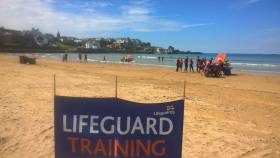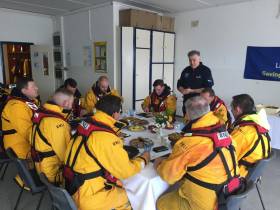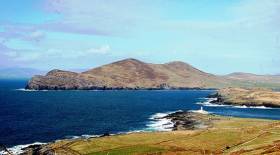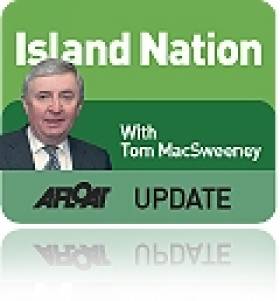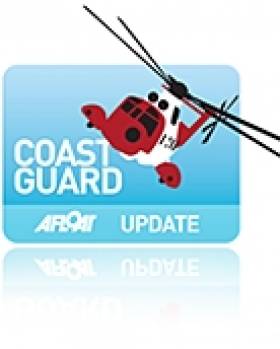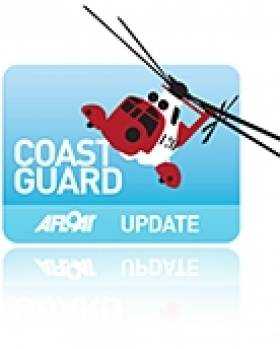Displaying items by tag: Valentia
#RNLI - RNLI lifeguards and the inshore lifeboat crew from Portrush RNLI rescued a swimmer who got into difficulty off Portrush East Strand on Wednesday evening (27 June).
The lifeguards who patrol the Causeway Coast beaches daily between 11am and 7pm were finishing up for the day when a member of the public raised the alarm.
The male swimmer had been seen entering the water 300-400m west of the patrol zone, towards Whiterocks, when he got into difficulty and was struggling to stay afloat.
Lifeguards Josh McCaw, Albert Dallas, Marcus McKeag and Nicola McIlroy immediately ran with their boards up the beach in the direction of the casualty.
Portrush RNLI’s inshore lifeboat helmed by Ben Wilson, was on exercise at the time when the crew spotted the lifeguards and immediately made their way to the scene.
The casualty was taken onboard the lifeboat and then transferred into the care of the lifeguards.
RNLI lifeguard supervisor Karl O’Neill said the situation could have been different minutes later. “Firstly, we would like to commend the member of the public who raised the alarm when they spotted someone in difficulty and we would like to wish the swimmer well after his ordeal.
“We want to remind everyone that while our lifeguards are busy patrolling our beaches daily, it is important to remember and adhere to our key safety advice both in and outside the patrol time of 11am-7pm.
“We were fortunate yesterday evening to be still on the beach when this incident happened and thankfully it resulted in a good outcome.
“We want to encourage people that when you plan a trip to the beach to check weather and tide times before you go and if planning to go into the water, to swim at a lifeguarded beach, between the red and yellow flags.
“We want everyone to enjoy this beautiful weather and to come to our beaches but we want everyone to do that with safety in mind knowing to always respect the water and to remain vigilant. If you get into trouble, stick your hand in the air and shout for help and if you see someone else in trouble, tell a lifeguard. If you can’t see a lifeguard, call 999 or 112 and ask for the coastguard.”
Elsewhere, Valentia RNLI volunteers launched their all-weather lifeboat yesterday afternoon (Thursday 28 June) to assist a 30ft motor cruiser with two people onboard, which had suffered mechanical failure.
At 2.37pm, Valentia Coast Guard requested Valentia RNLI's all-weather lifeboat to launch to the cruiser one mile south of Skellig Rock Little, Co Kerry. Weather conditions at the time were described as good with clear visibility.
Arriving on scene, a volunteer crew member was transferred to the casualty vessel to assist with setting up a tow, and the cruiser was towed safely back into Knightstown Harbour.
Speaking following the callout, Valentia RNLI volunteer lifeboat press officer Michelle Curran said: “With this stunning weather more people are taking to the water, we urge everyone to respect the water, always carry a means for calling for help and ensure all onboard know how to use it.”
#RNLI - Derry Clarke, owner and chef at the renowned L’Ecrivain restaurant, turned Valentia Lifeboat Station in Kerry into one of the country’s top dining sports on Friday (29 September) as he treated the volunteer lifeboat crew to a delicious Fish Supper to promote the RNLI’s latest fundraising initiative.
Clarke, who is also star of RTE’s Lords and Ladles, is supporting the RNLI’s Fish Supper campaign for 2017 from 13-15 October — and is calling on people across Ireland to sink their teeth into a delicious fish dish to raise vital funds for the lifesaving charity.
The menu for the lifeboat crew comprised a number of mouth-watering seafood dishes including cured salmon with cucumber, apple and dill; seafood chowder; Flaggy Shore oysters and Lambay Island scallops with cauliflower and raisins.
Local hotel and restaurant The Royal also got involved when chef Ryan Walsh added a surprise extra course of fish gratin.
Speaking while cooking al fresco at the lifeboat station, Clarke said: “It is an absolute pleasure to cook for the Valentia lifeboat crew. I love cooking for the RNLI, and seafood dishes are always a crowd pleaser.
“I do an annual BBQ for the RNLI with my wife Sallyanne on Sherkin Island and at Courtown in Wexford, so it’s about time I got out to the West Coast. The only issue is that you never know if you have enough food as lifeboat crew are always hungry.”
Clarke also urged anyone who hasn’t tried cooking with fish to give it a try and impress your friends and family while raising vital funds for the RNLI’s brave lifeboat crews.
“We are lucky enough to live on an island with a beautiful array of fish on our doorstep. It’s a wonderful idea for a fundraiser.”
The occasion was captured by photographer Jack Lowe, who is travelling around the UK and Ireland photographing RNLI lifeboat volunteers through a Victorian process that captures the stunning images on glass. Jack’s visit to Valentia RNLI marked his 100th lifeboat station.
Valentia RNLI coxswain Richard Quigley added: “Our pagers can go off at any time and many a meal has been interrupted for a lifeboat launch. Holding a fish supper is a great way for people to support us. They can sign up for a free fundraising pack and then enjoy hosting a fun evening with friends and family.
“If like us, you’re not Derry Clarke in the kitchen, then you can always serve up something simple like a fish finger sandwich or fish and chips. We really don’t mind.”
To receive a free Fish Supper fundraising pack, and to see some mouth-watering recipe inspiration, visit RNLI.org/FishSupper.
RNLI lifeboat crews across Ireland launched 1,136 times in 2016, rescuing 1,649 people. Kerry lifeboat stations launched 38 times and rescued 47 people in that same period, spending a total of 393 hours at sea on service.
Last year, chef Clodagh McKenna visited Howth RNLI to support the charity, which relies on donations from the public to continue its lifesaving service.
#RNLI - Valentia RNLI volunteers launched their all-weather lifeboat on Saturday morning (12 August) to assist three people onboard a fishing vessel with mechanical failure.
At 9.23am, Valentia Coast Guard requested the local lifeboat station to assist the vessel one mile south of Lemon Rock, near Skellig Michael.
Weather conditions at the time were described as fresh, with a north-westerly Force 5 wind.
Arriving on scene, the lifeboat crew were informed the fishing vessel was unable to return to harbour due to mechanical failure.
The volunteers checked that the three crew onboard the fishing boat were safe and well before setting up a tow to bring the fishing vessel safely back into Portmagee Harbour.
Speaking following the callout, Valentia RNLI lifeboat crew member Con O’Shea said: “The fishermen did the right thing calling for assistance. We urge anyone taking to the sea to always wear a lifejacket and carry a means of calling for help.”
I reported in detail the two battles which the people of Valentia fought against the Department of Transport and the Coast Guard to prevent the closure of the Coastal Radio Station on the Kerry island.
Valentia is fortunate to be linked by a bridge to the mainland, but has still suffered from emigration and deprivation which neglect by the State can cause to isolated communities.
I have a great respect for island people. They have to overcome difficulties and obstacles in their daily lives that those living ashore will not encounter.
Those battles and, at the same time, that of the people of Malin at the other end of the country, to prevent the closure of the Malin Head Coastal Radio Station came to my mind in the context of a technological development which changed the world and started in Valentia.
The Department, of which the Coast Guard is part - an indication of the unfortunate dispersal of maritime matters amongst too many Government Departments in Ireland - wanted to centralise operations in Dublin. In the course of my reportage, I discovered that their proposed location was in the constituency of their then Minister. Curious! Another proposed retrenchment from the regions into Dublin. There was little to justify the plan.
The people of Valentia mounted a particularly strong case against the proposal, backed by research and technological facts. Malin also produced a strong case. I wonder about the attitude of officials based in Dublin who come up with proposals like this.
These topics came up for discussion again when I attended the 150th anniversary of the laying of the first successful TransAtlantic communications cable from Valentia to Newfoundland. The laying of the cable began on July 13, 1886 when the biggest ship in existence at the time, the Great Eastern, sailed from Valentia. It arrived in Newfoundland on July 27, 1886 having laid 2,000 miles of cable weighing 9,800 tons across the Atlantic.
“The Valentia cable of 1866 changed the world,” writes Dr. Donard de Cogan in his book - ‘They talk along the deep,’ the story of cable history which was launched at the island ‘cable festival.’ “To put a cable across the ocean in the 19th century was cutting edge. These people were stretching beyond the technology of that time.” So says Bernard S.Finn. Curator Emeritus of the Electricity Collections at the Smithsonian Institution's National Museum of American History, Washington D.C.
In this edition of my programme, I talk to Anthony O’Connell, Director of Valentia Island Development Company, about the island community’s attempts to gain UNESCO recognition for the island as a World Heritage Site, a case based on the technological breakthrough which started there. Ireland has only two out of 1,000 World Heritage Sites in Europe. England, Spain and Italy have between 30 to 40 World Heritage sites each! It is a revelation to hear of the extensive research and campaign work done by the people of Valentia.
On reflection, the Department of Transport and Coast Guard were unwise to take on the people of Valentia!
• Listen to the programme above
Valentia Lifeboat Launches To Fishing Vessel Off Bolus Head
#RNLI - Valentia RNLI launched on Monday afternoon (27 June) to a 10m fishing vessel going aground off Bolus Head in Co Kerry after fouling its propeller.
The call for assistance came from Valentia Coast Guard at 3.44pm with Ballinskelligs inshore rescue and the Irish Coast Guard helicopter Rescue 115 also tasked to respond.
Ballinskelligs CRBI provided a tow to the vessel to remove it to safer water, where the Valentia lifeboat took over the tow for a short distance to free the obstruction from its propeller.
The skipper was then able to control the boat assistance and the tow was parted. The fishing vessel continued on without incident and Valentia RNLI returned to station.
Valentia RNLI Receives Big Donation From Star Wars Film Crew
#RNLI - Valentia's lifeboat station received a €10,000 donation from Star Wars producers during their recent film shoot on Skellig Michael.
As The Irish Times reports, the RNLI station's operations manager Richard Foran confirmed to a local paper that the lump sum came as "a complete surprise. But I think the lifeboat came to their minds because of what they were doing."
The good news comes after some controversy earlier this week over confirmed 'repairs' on Skellig Michael after the week-long film shoot on the sensitive Unesco World Heritage site.
Filming was delayed at the start of the shoot a fortnight ago due to high winds and rough seas common around the weather-worn island.
A Question Asked in a Kerry Boatyard
#islandnation – "Now, why would you say that Tom?"
And when Fionán Murphy rightly challenged me about my question, I did ask myself why I had just said:
"It's unusual, isn't it, for a boat for Norway to be built in Kerry?"
"I don't know why you would say Kerry, Tom," Fionán said back to me. "Ireland maybe, but why would you say 'Kerry'? The guy involved found us, came over to us and we have a fantastic relationship with him. He has been here for two months and he will be here with us until the boat is finished. It is a great place to do business because the Norwegian currency is very strong. To do anything in Norway costs a fortune, so they are getting great value for money here and we are still getting a good price for our product. It is a great place to do business and if we can do more business there, it will be fantastic."
It was a bright exchange which I enjoyed, because it is good for an interviewer to be challenged. I was trained in radio broadcasting in the days when the interviewee was the most important person, not the interviewer. Too much of radio now centres on the personality of the programme presenter, not the interviewee. I still believe that the interviewee is the most important part of an interview, so Fionán and myself chuckled at my gaffe and as Managing Director and the man who owns Murphy Marine Services on the Shore Road in Valentia Island and so an islander, he made a strong point about Kerry and the importance of our offshore islands. I was talking with him and other members of the island community who were making the point that the Government does not show enough commitment to Ireland's offshore islands. I interviewed Fionán about the future of the island and how his boatyard, which builds, maintains and stores boats, is going.
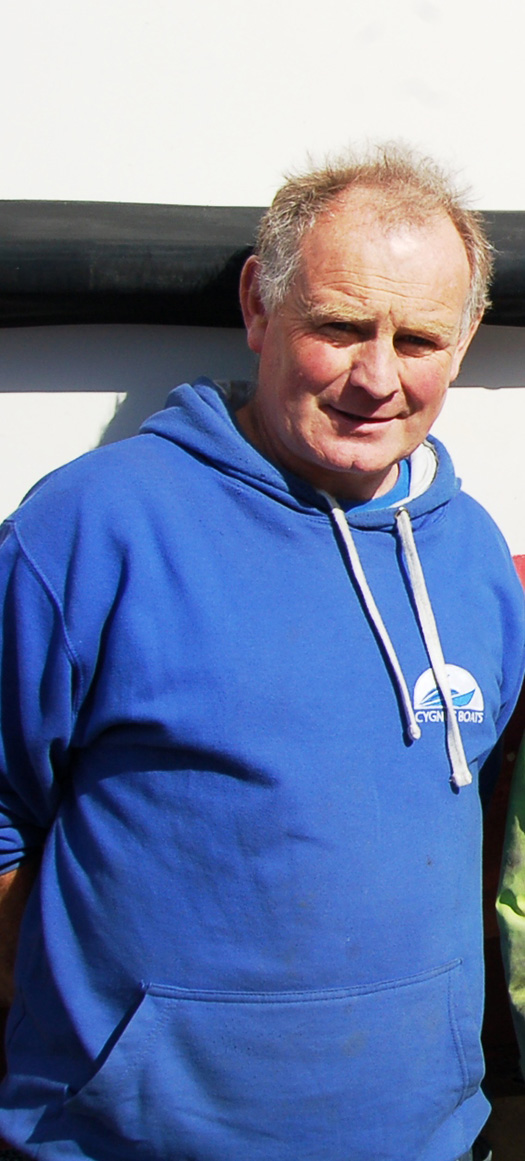
Fionán Murphy of Murphy Marine Services, Valentia Island
"Our predominant thing is new builds. If we get four-to-five of those a year we would be very happy. This keeps jobs on the island and that is what we need."
Fionán is also Chairman of the island's Development Company:
"Rural Ireland is in decline and we are doing what we can, but the island needs people and people need jobs to stay here. Islands need special recognition from the Government."
Fionán tells me in the interview, which you can hear here, how he started the yard fourteen years ago and how it has developed to its present stage of building boats which are sold all over Europe and how he overcame the economic, recessionary downturn.
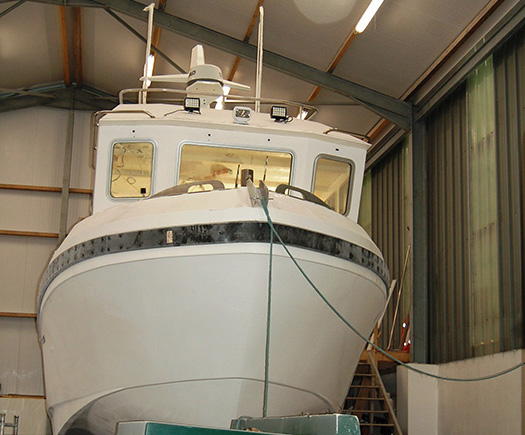
A new fishing vessel built in Valentia and bound for Norway
You can hear him on this current edition of THIS ISLAND NATION, Ireland's niche maritime programme, now broadcast on seven radio stations around the country and on this website. Also on the programme, the value of maritime safety training is emphasised by the interim Chief Executive of Bord Iascaigh Mhara, Michael Keatinge, who outlines how three fishermen's lives were saved when their boat capsized off the East Coast, because they had done the BIM safety course.
There's a lot more to be heard on THIS ISLAND NATION and you can Email me direct about the programme to: [email protected] or leave a comment below.
The Minister for Transport, Tourism and Sport, Paschal Donohoe TD, today marked the commemoration of 100 years of services at the Irish Coast Guard Valentia Marine Rescue Sub-Centre (MRSC). A plaque unveiled by Minister Donohoe pays tribute to all the members of staff, both past and present, who have served in the centre over the past 100 years.
The Valentia MRSC has been in operation since 1914 and covers the South West and Western Atlantic coastal area. It has served as the first point of contact for the liners and cross Atlantic vessels transiting to and from Europe to America.
Speaking at the event, Minister Donohoe said: 'I am very happy to have an opportunity to pay tribute to all those who have served here in the past and also to those who continue to serve at Valentia Coast Guard, most of whom have been here for many years'.
"When I look around at this state-of-the-art Coast Guard coordination centre at Wireless Point, it is difficult to imagine that it was from this very location on the 7th May 1915 that some of the last messages to the ocean liner Lusitania were transmitted using only Morse Code. Through two world wars the station here continued to operate serving the maritime sector and providing a lifeline and communications link to shore. Looking over the records of the incidents handled here, there have been many notable incidents over the years.
"Our seas and inland waterways can bring tragedy as well as joy and we would like to remember here all those who have lost their lives in an around our coast and we acknowledge the sadness of that loss for their families and friends.
"The last two years have seen the busiest period in many years for the Coast Guard in terms of emergency responses as the figure for coordinated incidents reached 2,628, with the centre here in Valentia coordinating some 940 of these incidents.
"So it is in recognition of all these efforts and many others down through the years, that we have gathered here over 100 years after services commenced, to acknowledge the long and proud history of the station here in Valentia".
Valentia and Malin Head Coastguard Stations Will Not Be Closed Says Minister
#COASTGUARD - BreakingNews.ie reports that the coastguard stations at Malin Head and Valentia will remain open, following a statement to the Dáil by the Minister for Transport this evening.
Coastal communities in Donegal and Kerry had been protesting against plans to close their respective Irish Coast Guard radio stations in the wake of the 'value for money' report commissioned earlier this year by the office of Transport Minister Leo Varadkar.
Both stations were earmarked for potential closure amid concerns that the minister was allegedly looking at an "alternative technical solution" within his own constituency in Blanchardstown.
However this evening Minister Varadkar assured local communities that their coastguard centres would not be closed, while also expressing disappointment at the treatment of officials from his department at a recent joint committee meeting on the matter.
Meanwhile, the Save Our Station campaign group at Valentia has welcomed the news, telling RTÉ News that "common sense has prevailed".
Spokesperson Anthony O'Connell said that he hoped the minister's move marked the end of any threat to the future of the stations at Valentia and Malin Head.
The news comes just two weeks after an East Londonderry MLA sought the support of Northern Ireland's Minister of State to protect the Malin Head station from the chop.
#COASTGUARD - The Irish Examiner reports today that the Irish Coast Guard has severely criticised the first draft of the 'value for money' report on the coastguard service commissioned by Transport Minister Leo Varadkar.
Senior IRCG management berated the work of the consultants Fisher Associates who were commissioned to undertake the studies into the coastguard and Marine Survey Office.
In their observation of the report's first draft, they cite "uninformed or poor analysis; lack of dialogue on matters surfaced; lack of understanding of where the IRCG has competency or control on particular matters and where they are departmental competencies; laziness in fact finding; ignorance of how coast guards function and failure to recognise command and control issues."
They also slated "sloppiness" in the report's incorrect spelling of the service as the 'Irish Coastguard', arguing that it "reflects very, very poorly on Fisher's ability or competence in these areas".
The news comes ahead of Irish Coast Guard director Chris Reynolds' appearance before the Oireachtas Transport Committee tomorrow (Wednesday 24 October) to discuss the future of the national network of coastguard stations.
Fianna Fáil Senator Mark Daly, who worked to bring Reynolds before the committee, claims that the coastguard head's agenda is to close the stations at Valentia and Malin Head while retaining the Dublin station and a sub-base in the Transport Minister's constituency.
Elsewhere in the Irish Examiner, Dan Buckley comments on the local campaigns to save the "vital" bases at Valentia and Malin Head.
As previously reported on Afloat.ie, coastal communities in Kerry have joined with their counterparts in Donegal to protest mooted plans to close their coastguard radio stations, despite the wealth of local expertise and hundreds of thousands of euro worth of recent investment.





























